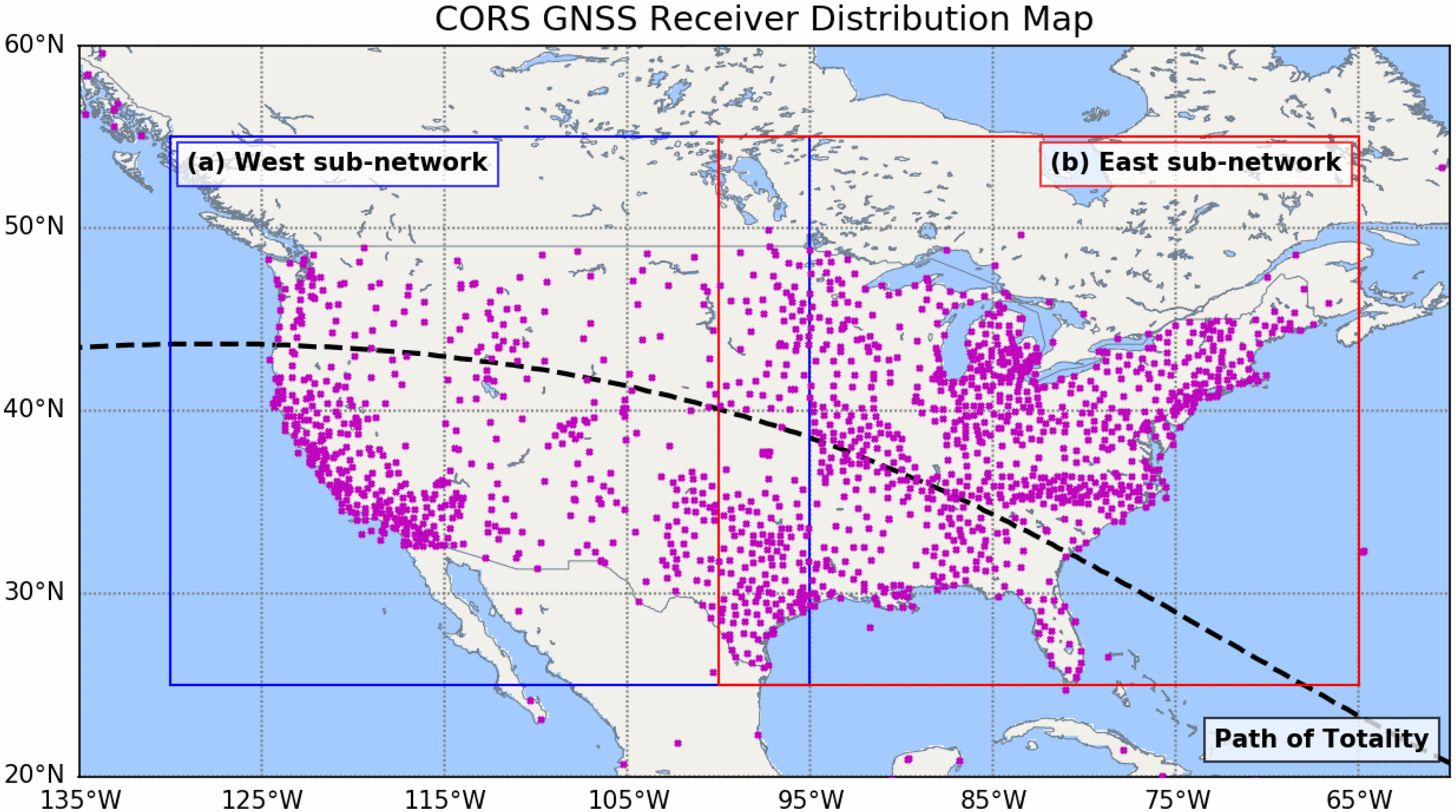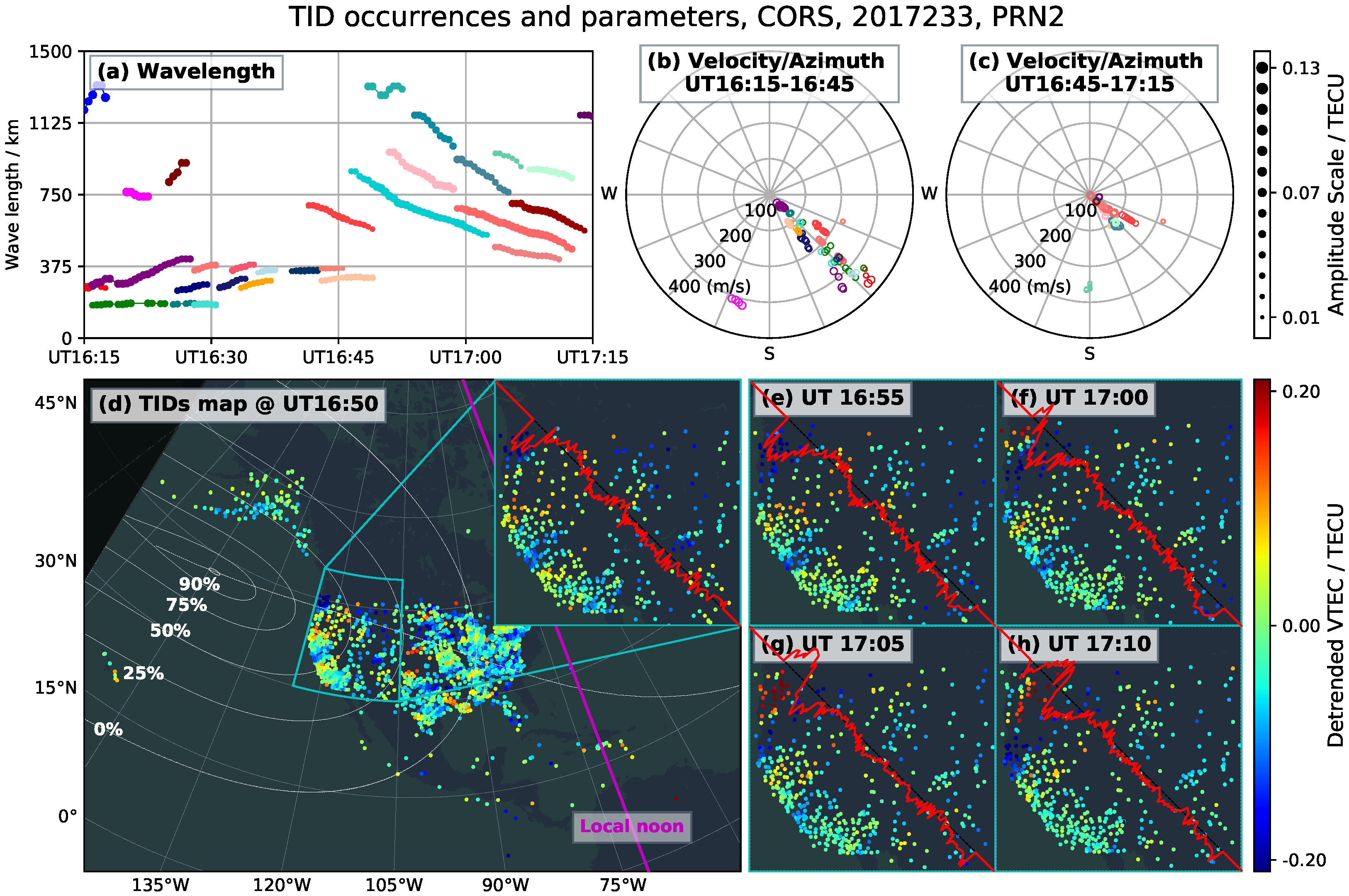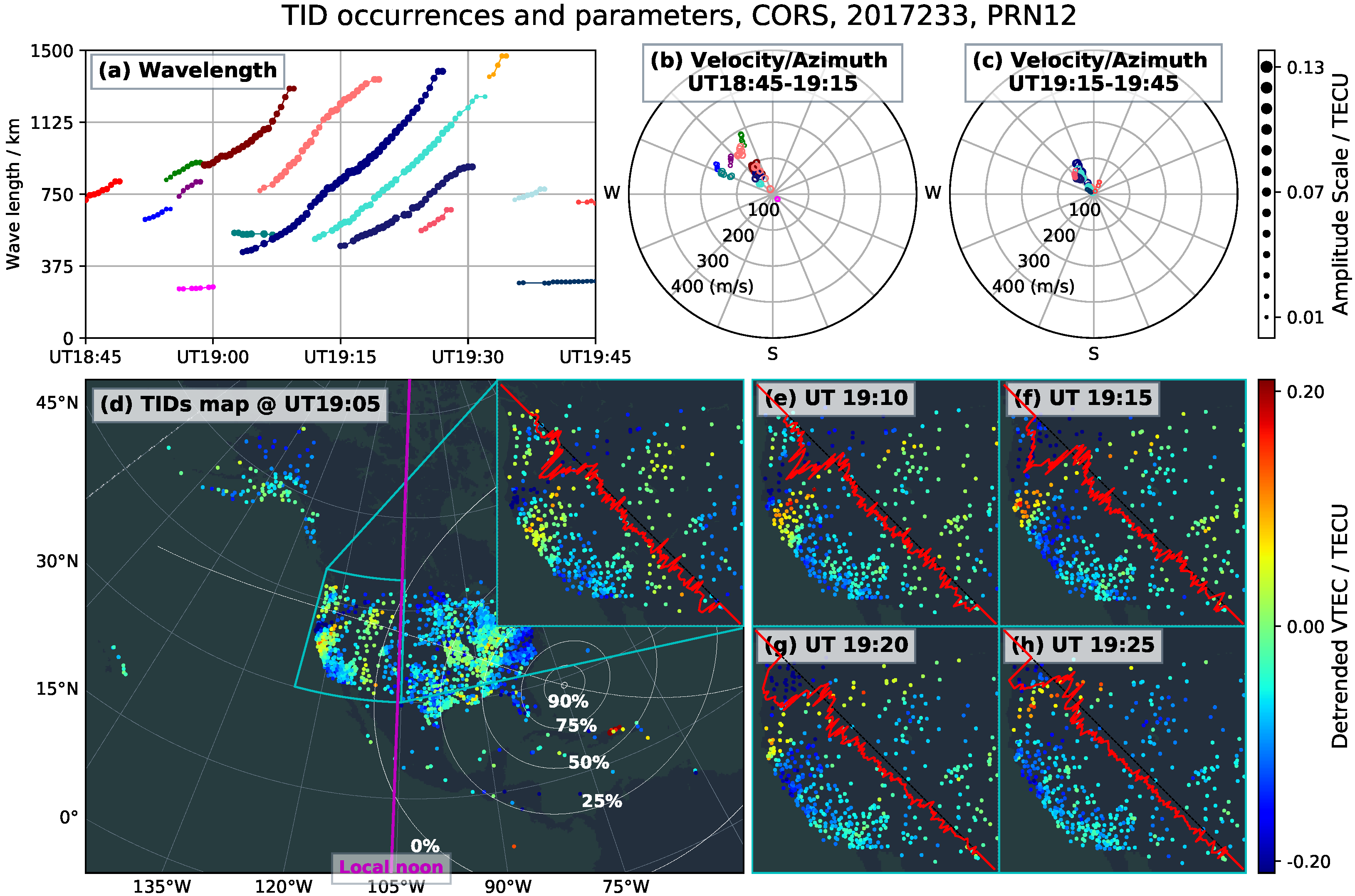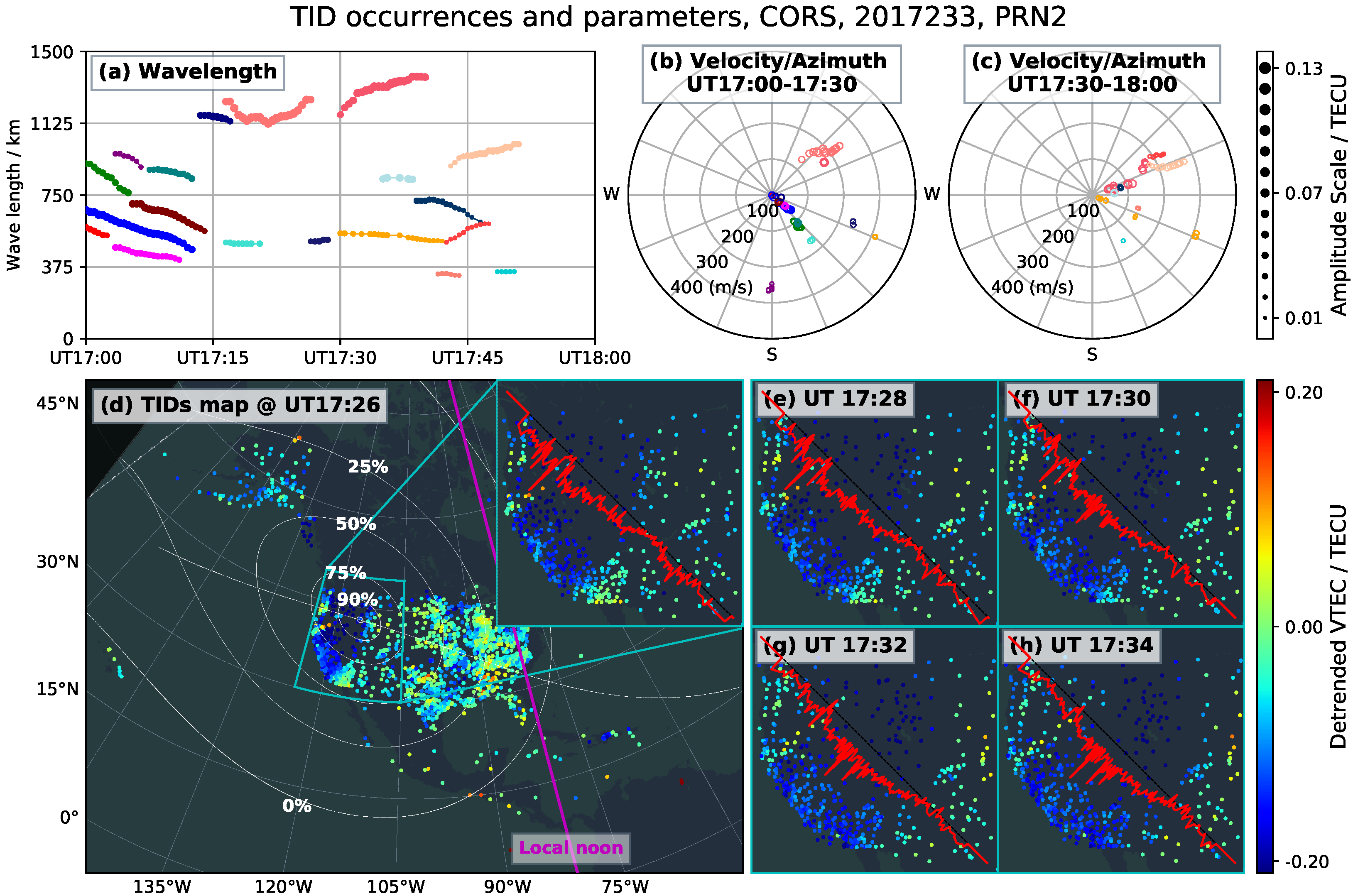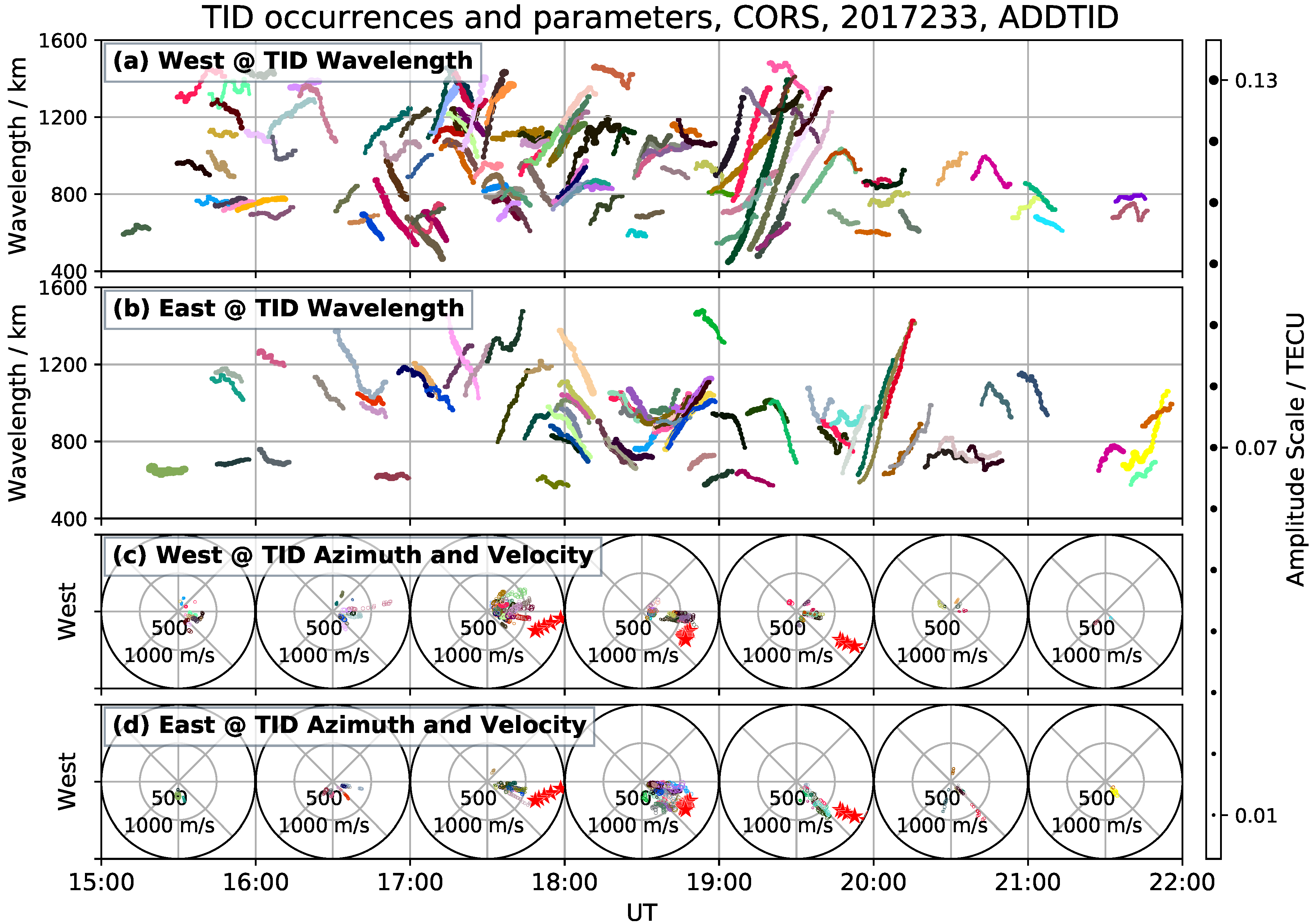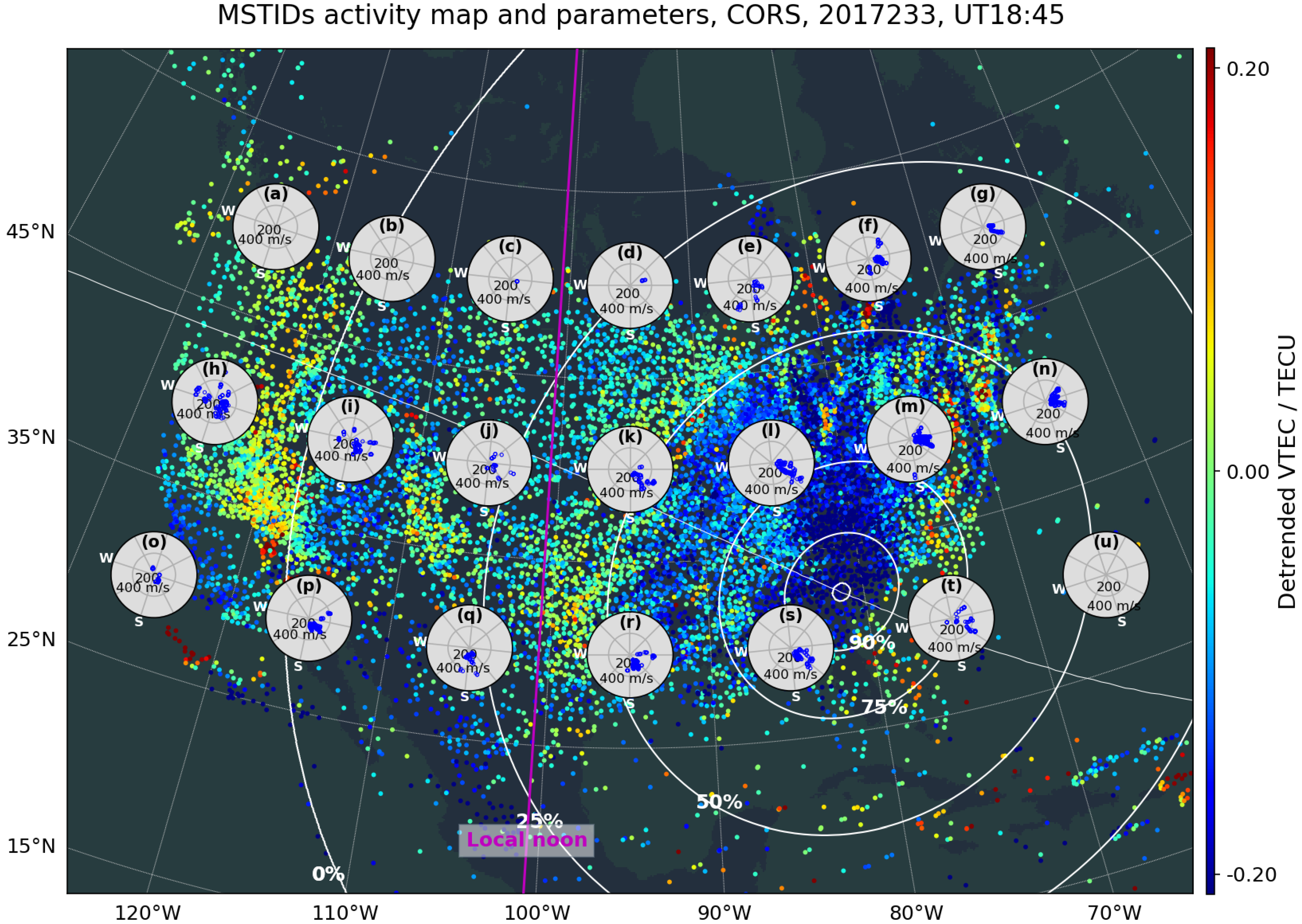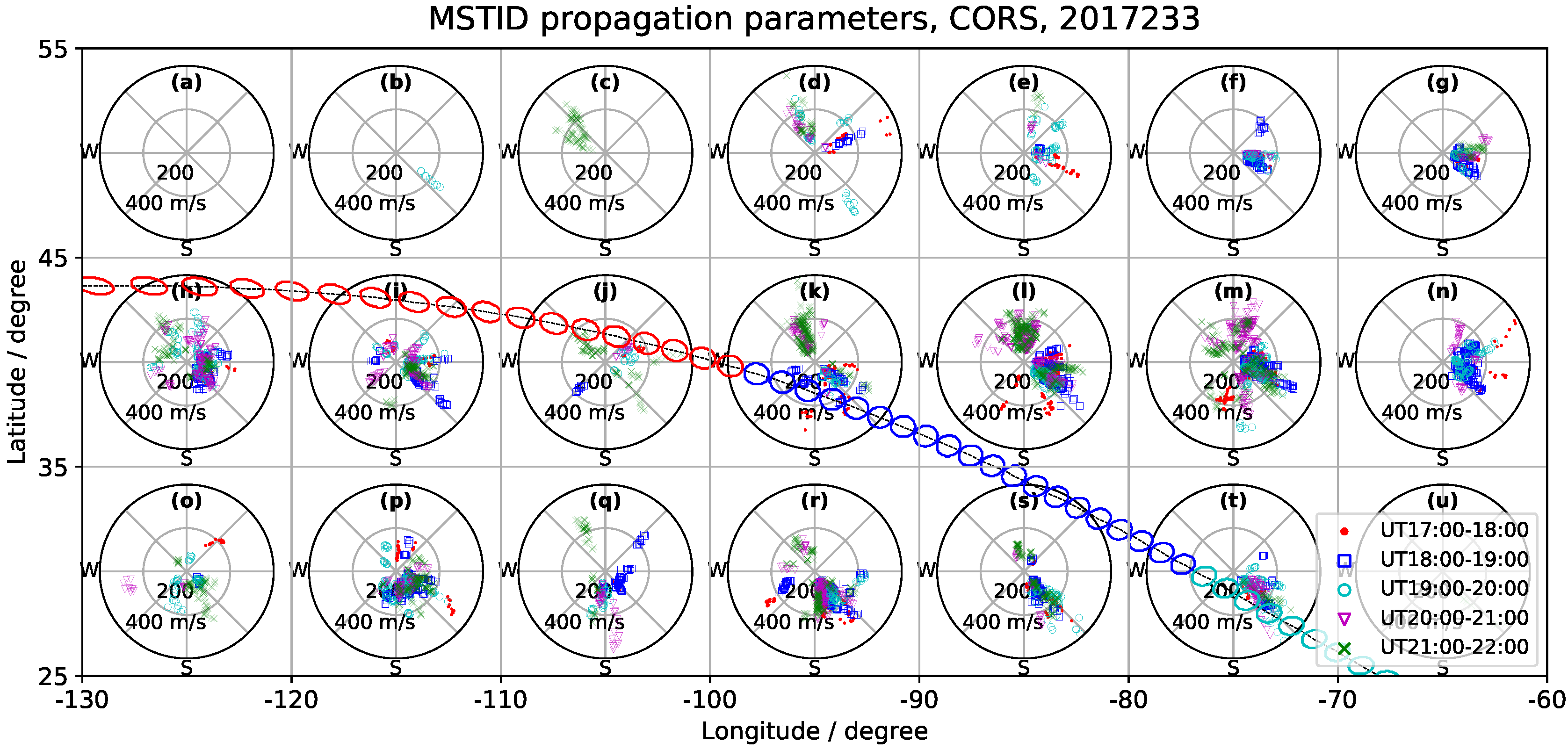In this section, we will analyze the diverse types of ionospheric disturbances generated during the eclipse transit at a height of 250 km. The analysis will be done both, by means of the ADDTID algorithm and by visual inspection of the maps. The TIDs that we detected (and visually verifed) show a wide range of features that depend on the elevation angle change, the footprint, size, azimuth and velocity of the umbra. We have structured the analysis of the generated TIDs, first following the temporal evolution of the eclipse and finally a global summary:
4.1. Time Varying TIDs Wavelengths in the Early and Final Stages of Eclipse Transit
In this section, we will describe the temporal evolution of the TIDs in the early and final stages of the eclipse. The description will be carried out simultaneously, by means of the parameters detected with the ADDTID algorithm and by visual observation of the maps for verification purposes.
The disturbances that appear in the early and final stages of the eclipse, coincide with the distribution of the TIDs when the umbra either is about to enter the continent or to leave it. The eclipse-induced ionospheric perturbations would primarily be the consequences of the atmospheric cooling effect at all heights. However, the response of the ionosphere to the cooling due to the rapid variation of the penumbra is not well understood. As is shown in the model of
Figure 2, where the lines of iso-penumbra and umbra (see computation details in Montenbruck and Pfleger [
35]), are superimposed with the simulated global horizontal irradiance color map (see simulation details in Andrews et al. [
36]). The consequence is that the movement of the shadow, generates fast space-varying and time-varying cooling effects at the atmosphere. This movement is in part, due to change in the grazing angle at the different stages of eclipse. The main feature is that for grazing angles of the umbra, the penumbra creates elliptic-like shadows of gradual obscuration. On the other hand, for vertical angles the shadows of the penumbra show less eccentricity. The geometry of the problem gives rise to a changing velocity of the penumbra shadows. That is, while the angle increases steadily, the velocity of change of the elliptical shadow of the penumbra will be high during the transition from grazing angles to medium angles.
As reported in Zhang et al. [
14] and Sun et al. [
16], the eclipse-induced ionospheric disturbances can be classified into two categories with distinct scales: (a) bow-shaped large scale TIDs and (b) medium scale TIDs of bow waves, originated respectively by in situ and not in situ gravity wave effects. In this subsection we will study both kinds of the disturbances in a separate subnetwork centered at California, (see in
Figure 1). The California network is defined as a more restricted geographical area, which covers a smaller region, with a high density of stations allowing a more clear detection and modeling of the TIDs, because they can be locally approximated by a planar wave. Another reason we limit ourselves to this subnet is that for grazing angles, the distribution of TIDs will be very different across the continent, which could result in a mixture of different effects. The result of this change in angle, is the emergence of a set of TIDs, with a wavelength time evolution that follows a parabolic shape. This parabolic shape of the evolution in time of the wavelength is common to the entering and departing phases of the umbra and penumbra.
4.1.1. The Early Stages of Eclipse Transit
Figure 3 (GNSS observation of GPS satellite PRN2), shows the entry phase of the eclipse.
Figure 3d–h show TEC maps of the west coast between 16:50 UT and 17:10 UT. Superimposed over these maps, we show the isopenumbra lines from
to
of obscuration, when the umbra is over the Pacific ocean. By means of the algorithm presented in Montenbruck and Pfleger [
35], the lines of isopenumbra are depicted at an altitude of 250 km, and the measurements over the set of stations over the continent. The lower right part, shows a zoom of the TEC evolution at time intervals of 5 min. The upper part of the figure shows the time evolution of the TID wavelengths (
Figure 3a) and the two polar plots of azimuth vs velocity (
Figure 3b,c). Wavelengths, azimuth, velocity and amplitude are all estimated by the ADDTID algorithm. Please note that the azimuths and wavelengths given by the ADDTID coincide with the values that can be estimated at glance from
Figure 3d–h. In addition we have overlaid on the maps, the projection of the detected points to a straight line with an inclination equal to the most common azimuth of the detected TIDs. Please note that the projection allows the visual inspection to determine the approximate wavelength of the disturbances and the propagation azimuth. As a supplement to
Figure 3, we have posted on the Internet VTEC variation films during the eclipse in [
37].
Next, we will describe the evolution of the TID estimated by means of the ADDTID algorithm and we will contrast it with the measured maps. Beginning at 15:55 UT, the penumbra contacts the ionosphere over west US region, and from then on, increasingly covers this region. The time evolution of the TIDs in the early 30 min, show Medium Scale TIDs (MSTIDs) with a wavelength in the range of 250 to 300 km, a propagation following an azimuth towards the southeast. Please note that although the distribution of velocities is broad, most of the observations (
) are concentrated in the range 150–300 m/s. The amplitudes during this time interval decreased from 0.08 to 0.02 TECU. The color-coding convention we have followed assigns a different color to each continuously detected TID sequence. The same colors have been assigned to the wavelength paths and points in the azimuth vs. velocity diagram. The MSTIDs detected during local morning hours show the typical daytime pattern in summer, mostly driven by solar terminator, see similar reports in Hernández-Pajares et al. [
30]. At about 16:45 UT, the MSTIDs suddenly disappear, and a set of long wavelength TIDs emerge, that show a downward trend starting at a value of 1125 km. This change coincides with the arrival of the penumbra at a level of obscuration of 50–75%, as can be seen from the geographical distribution of the iso-penumbra lines at
Figure 3d. The azimuth of the long wavelength TIDs moves 10 degrees to the east, and the velocity as seen in
Figure 3c decreases to 150–50 m/s and the period decreases to a range of 3–0.75 h. This can be confirmed by visual inspection of
Figure 3d–h. Meanwhile, the umbra above the Pacific ocean moves toward to east at speed of about 3000 m/s. Around 17:15 UT, 55 min after the onset of the penumbra reaches the network, the penumbra reaches a
obscuration, and the wavelength of the TIDs converges to a value of 400 km. As shown in
Figure 5, this occurs a few minutes after the umbra contacts the California network.
The phenomena that we have described can be explained from the physical point of view in several ways (see discussion of the literature on this topic in the introduction). Zhang et al. [
14] observed the penumbra-induced TIDs and recognized as the partial bow waves which should originate from the neutral atmosphere when the ground shadow is of about
magnitude. The time interval between the onset of TIDs and the time when the penumbra first arrives in California is compatible with the 0.5–1 h delay range of the onset of TIDs according to Liu et al. [
12] and Nayak and Yiğit [
15]. Another phenomena, that are observed in this paper are the bow waves and related disturbances, and the different delays in the apparition of the ionospheric disturbances. Shock waves are believed to originate from gravity waves in the middle atmosphere, due to the umbra moving at supersonic speeds. On the other hand, the penumbra that partially covers the solar radiation produces a cooling mechanism different from the umbra. This effect encompasses several frequency bands, Huba and Drob [
17] indicate that the moon blocks the irradiance of ultraviolet light (uniform in the solar disk) in a similar way to light in the visual spectrum. In Kazadzis et al. [
38], it is observed that a significant part of the ozone column decreases when the obscuration associated with darkness exceeds
. As the column variation in the ozone layer, absorbs most part of UV radiation, the cooling effects by the low obscuration penumbra were not enough to break the heat balance in the middle atmosphere. Therefore, these TIDs observed tens of minutes prior to the coverage by the
obscuration penumbra, might have a different origin. The global horizontal irradiance of the region covered by the umbra and penumbra is depicted in the diagram of
Figure 2. The decreasing intensity of the irradiance from center outwards, generates different cooling effects, similar to a solar terminator, with a very fast diurnal variation. For instance, Huba and Drob [
17] report the delayed variation of irradiance of X-ray and Extreme UV (EUV) because 10–20% contribution in these bands are generated at the solar corona, which is not covered by the moon. While the X-rays and EUV photons which are the primarily source of photoionization in the ionosphere, is occluded by the moon. On the other hand, Coster et al. [
3] observed the TEC depletion follow with a short time delay the radiation distribution induced by the umbra and to the percentage of penumbra, and reported the penumbra-induced large scale TIDs activities could be originated in situ with the thermosphere. This explains the above mentioned set of long wavelength TIDs, that appeared suddenly when the coverage of the penumbra reached the
of obscuration, and the following convergence of the TIDs about a few minutes after the umbra reaches the network. Also is compatible with the ionospheric disturbances reported by Le et al. [
4], Müller-Wodarg et al. [
39] and Sun et al. [
16], which would be directly generated in thermosphere.
Figure 3 shows that the wavelength trajectory of long wavelength TIDs follows a descending parallel parabolic shape. This path is compatible with decreasing the distance between the isopenumbra lines. That is to say, the solar irradiance gradient increases as the angle of the shadow increases from 6 degrees to 40 degrees, with the consequent reduction in the rate of variation of the isopenumbra lines. At the same time, the direction of propagation (southeastbound) of TIDs is perpendicular to the isopenumbra lines over the California network. The cooling effect on the California area increases considerably as the angle and speed increases. This speed is supersonic at the heights where disturbances occur. In conclusion, this shows that the deceleration of the rate of change of the area of the penumbra and the decrease of the such area, is associated with a decrease of the wavelength of the TIDs. This happens in spite of the fact that the speed of the TIDs is slower than that of the umbra.
As for bow waves, the shape of the TIDs induced by the penumbra is consistent with bow waves of variable aperture in the south direction. One aspect to note is that the geomagnetic lines give rise to a slight deviation towards the equator due to the low geomagnetic activity, as mentioned in
Section 2, see Coster et al. [
3].
4.1.2. The Final Stages of Eclipse Transit
In
Figure 4 we show, for the departing phase of the eclipse. For more details see the movie in [
40]. The measurement has been made in the California subnet when the umbra is over the Atlantic Ocean, which results in a grazing angle of the penumbra. The parameters shown in the figure were estimated on the west part of CORS GNSS network, using the GPS satellite PRN12. The temporal evolution of the wavelength shows, for the departing phase, a complementary behaviour to that observed in the entering phase of the eclipse. The differences are due to the fact that the decrease rate of change of the elevation angle of the moon is not exactly the opposite of the entering phase of the eclipse (see
Figure 2). On the other hand, the azimuth of the detected wavefronts is compatible with the direction of the isopenumbra lines over the network.
At about 19:35 UT the TIDs with increasing wavelength get weaker and finally disappear when the wavelength is over 1200 km. Subsequently, the activity of the disturbances decreases significantly, after which only very low intensity TIDs are detected. These disturbances have an azimuth opposite to that of the typical disturbances of this time of year.
The TIDs that have been detected show similarities with those of the initial stage, in the sense that the direction of propagation is perpendicular to the isopenumbra lines, the range of velocities is similar, and they are not significantly affected by the geomagnetic fields. A difference with respect to the TIDs of the initial stage of the eclipse is that the propagation is in the opposite direction to the movement of the shadow, which indicates that there may be no relation with the variation of the penumbra. In addition, these TIDs occur at the time when the shade is at its lowest, i.e., when the shadow leaves the California region, about 105 min after the umbra and about 85 min after the isopenumbra level of
leaves the subnetwork. This suggests that the fluctuations of the ionosphere are not due to the direct cooling effect in the thermosphere, but are upward gravity wave disturbances originating in the neutral atmosphere. Nevertheless the behavior of the TIDs differs from Coster et al. [
3] and Zhang et al. [
14], Chimonas and Hines [
5] explains the above-mentioned behavior of disturbances by stating that long period atmospheric gravity waves cannot ascend from the point of generation at a sufficiently steep angle. From theoretical considerations, they conclude that the period of the disturbances is 3 to 4 h, which is in line with the results of the estimate we have made. The period of the TIDs detected in F region, increases gradually from 1 to 5 h. Similarly, in a study related to the 7 March 1970 eclipse, Davis and Da Rosa [
9], in synchrony when the penumbra boundary (i.e., 0% area) left the network, observed westward TIDs in the form of decreasing amplitude shock waves with gradually increasing periods. However, the period of the TIDs estimated was of about 25 min, which was not consistent with the predicted long period in Chimonas and Hines [
5].
4.2. General Description of the Multi-Scale TIDs (Medium and Large) in the Middle Stage of Eclipse Transit
In this subsection, we show the presence of the multi-scale TIDs, i.e., medium and large, measured from the California subnetwork.
Figure 5 shows the characteristics of ionospheric perturbations when the umbra crosses the California subnetwork. For more details see the movie in [
37]. The umbra contacts the atmosphere above this region at a height of 250 km at about 17:11 UT and leaves the subnetwork at about 17:42 UT. As mentioned in
Section 4.1 during the early stage, the set of parallel wavelength-varying TIDs from 17:00 UT follow a downwards trajectory, converging towards a medium scale wavelength TID of about 400 km, 4 min after the arrival of the umbra. Almost simultaneously, with a slight delay due to the response of the ionosphere (see
Figure 5a), a disturbance suddenly appears with a wavelength of 1125 km at about 45 degrees of azimuth, nearly 90 degree to the north of the medium scale TID azimuth. This perturbation corresponds to the three segments of the trajectory observed at
Figure 5a. Please note that the trajectories of large-scale disturbances are reflected on the projection (in red) in
Figure 5e–h, as almost two cycles of a sine wave with a wavelength compatible with 1200 km.
Both disturbances persist between 17:15 UT and 17:45 UT, the long scale disturbance with an amplitude of about 0.11 TECU and the medium scale of about 0.05 TECU for other. The spread in terms of azimuth of both perturbations shifts several degrees towards the east, which is compatible with the lines of equal penumbra and perturbations shown in
Figure 3. The disturbance of longer wavelength can be found by visual inspection in
Figure 5.
Although the observed velocities of both sets of TIDs are lower than the typical velocities for large and medium scale TIDs, there is a consistency, in the sense that the large scale TIDs propagate at a double speed compared to the medium scale waves.
Note also, that of the size and distribution of the stations is lower than the area covered by the bow wave, therefore only one of the branches of the bow wave is detected in the figure. Another effect that can be observed at the maps and the wavelength vs. time figure (
Figure 5), is that the amplitude of the large scale TIDs is greater than in the case of the medium scale TIDs (note that the amplitude is coded by the size of the dots). An additional observation from this Figure, is that the azimuth of the TIDs does not coincide with the trajectory of the eclipse on the maps. This might be related to the movement of the bow wave fronts both in large and medium scales. In the figure there are also disturbances that appear in advance of the umbra.
These medium scale TIDs are a response of the ionosphere to the transition from the penumbra to the umbra, which generates the ionospheric wave in situ. Whereas long scale TIDs are also due to the effect of the umbra on the ionosphere, with delay appearing after the umbra has already moved away [
16]. These TIDs originate in part due to the cooling effect of the umbra’s shadow, creating gravity waves in the thermosphere.
4.3. Description of Ionospheric Disturbances during the Eclipse
In this section will characterize and describe the ionospheric disturbances related to the bow waves during the transit of the eclipse.
By visual inspection, in the maps plotted at
Figure 6a, one can see a bow wave that varies gradually at the different stages of the eclipse (see more details in [
41]). In the three maps, in addition to the bow wave, it is also possible to observe disturbances in advance of the umbra, and in the wake of the umbra (see similar observations in Zhang et al. [
14]). The shape of the waveforms of the disturbances are akin to the lines of iso-penumbra in
Figure 2. That is, the disturbances in advance of the umbra follow the shape of the lines of iso-penumbra. The disturbances in the wake of the umbra show an elliptical curvature following the shape of the lines of iso-penumbra, and also ripples (
Figure 6a at 18:45 UT) of lower wavelength with a complementary curvature.
In
Section 4.1 and
Section 4.2, we show on the west coast, the occurrence of disturbances at medium and large scales, ranging from a few hundred to more than a thousand kilometers. This phenomenon can be seen on the maps in
Figure 6a. In
Figure 6c, we also show that the measurements done on the east coast, follow with a delay, the shape of the wavelength evolution on the west coast.
These ionospheric disturbances during the eclipse appear as patches of 2D non-concentric near circular wave patterns, moving horizontally. Since the curvature of the TIDs over the region of each network is small enough, the ADDTID algorithm will be able to correctly detect the disturbances and estimate their characteristics. To better understand the spatial-temporal characteristics of large-scale ionospheric disturbances and their relationship to the eclipse, the estimation has been made with the entire CORS network. That is, the GNSS data used in the ADDTID algorithm correspond to the two subnetworks into which we have divided the CORS network (see
Section 2). Please note that each subnet is at least twice the maximum wavelength.
Figure 6b,c, show the time evolutions of the TID wavelengths respectively detected from west and east subnetworks of the CORS network.
The disturbance in advance of the umbra that can be understood as an early bow wave. The origin is due to the changes in temperature generated by the increasing penumbra, giving rise to disturbances of lower intensity in comparison with the one that was generated by the umbra [
4,
39]. As the penumbra moves at a higher speed for grazing angles, the perturbation due to the eclipse appears some time before the umbra reaches the region covered by the stations. Also, follow a distribution similar to concentric ellipses, which is due the change on the angle of the umbra over a sphere (see for instance the diagram in
Figure 2 and the previous discussion in
Section 4.1). These disturbances in advance to the bow wave can be observed clearly in
Figure 6a at 17:15 UT.
The measures done at the stations over the west subnetwork show that the typical pattern of MSTID at this time of the year, disappear completely, while on the east subnetwork, which is at the other side of the continent, they are reduced in number. In both cases the behaviour of the large scale TID (LSTID) change, in case of the west subnetwork there is a noticeably decrease in the wavelengths of these disturbances. With a delay of about half an hour, the same phenomenon appears on the east subnetwork. A remarkable aspect is the continuity between the MSTIDs and the LSTIDs, which can be seen in
Figure 6a or zoomed at
Figure 3. Also it can be seen in
Figure 7(c,d) from the azimuth vs. velocity plot that the direction of the large scale disturbances in consistent with the direction of propagation of the umbra. This continuity of the transition between MSTIDs and the LSTIDs and vice versa can be observed at both networks. As for the LSTIDs propagation (
Figure 6a at 17:15 UT), the disturbances follow the lines of iso-penumbra and propagate in the direction of the movement of the eclipse, except at the east edge of the continent, where the angle varies slightly, perhaps due to propagation delay. Around 18:00 LSTIDs with similar behavior appear, with a greater opening angle, and a direction that follows the movement of the umbra, see the more details in
Section 4.4.
The complementary behaviour is shown in
Figure 6a at 18:45 UT, where we observe the disturbances that appear when the umbra is over the west coast. In this case we observe LSTIDs to the west of the umbra that follow the shape of the lines of iso-penumbra, with wavelengths that increase slowly from 700 km to 1300 km. In addition, at the same time, MSTIDs of lesser wavelengths, with a front waves with a curvature of opposite sign. These MSTIDs have a wavelength of about 200 km, and on the map appear as ripples that can be observed at the west of the umbra. This transition can be seen more clearly in the zoom at
Figure 4a, and the azimuth vs. velocity plot of
Figure 4b,c, shows that the perturbations propagate in opposite direction to the propagation of the umbra. In
Section 4.5 the MSTIDs which correspond to the ripples are explained in detail.
4.4. Description of the Large Scale Ionospheric Perturbations Related to Variable Angle Bow Waves
In this section we extend the characterization done in
Section 4.3 of the behaviour of the large scale ionospheric disturbances (i.e., LSTIDs) during the eclipse transit. The behaviour of the LSTIDs during the eclipse is summarized in
Figure 7, in which we show time-aligned: (a) wavelength path (
Figure 7a,b) and (b) velocity vs. azimuth polar plots (
Figure 7c,d). This diagram will allow us to understand the relationships between these characteristics throughout the eclipse transit.
The LSTIDs shown at
Figure 7a,b have similar wavelengths and velocities as the typical large scale TIDs [
42], nevertheless the directions as shown at
Figure 7c,d are different, following the azimuth of the umbra center, which is denoted in the polar plots with the red stars.
Before the arrival of the eclipse to the continent, the LSTIDs exhibited a quiet behaviour, characterized by low amplitude and propagation mainly in the equator-east direction. The duration of the disturbances was less than 15 min, the speed was low of about 100–200 m/s and with long periods in the order of 1.5–2 h. At about 15:56 UT, the penumbra arrives first at the ionosphere 250 km above the west coast of US, from then on, the penumbra increasingly covers this region. At the same time the number of LSTIDs increases. During the time interval 16:10–17:15 UT, when the 10% iso-penumbra line reaches the western US, the properties of the TIDs change. The LSTIDs now head eastwards, with a marked increase in the speed (over 500 m/s). The wavelengths of the LSTIDs, decrease from about 1500 km to 800 km, and then increase above 1200 km. Please note that the delay between the west and east US, in terms of the evolution of LSTIDs, is approximately half an hour, which is consistent with the delay due to shadow propagation. This delay was computed from the shape of the wavelength trajectory observed in the figure, in particular from the position of the minimum of the parabola that is repeated at each coast.
At about 17:15 UT, a large number of LSTIDs suddenly appear, a couple of minutes after the umbra arrives the west US. At the west network between 17:15 UT and 18:05 UT (about 18:05 UT, the umbra leaves to the west part of US), the wavelength path of the LSTIDs shows a parabolic shape, the edges of this trajectory are determined by the entering and leaving phase of the penumbra (see comments in
Section 4.1). The disturbances show an eastward propagation, with an azimuth scattering of 60 degrees and a speed range between 300 and 700 m/s.
In the velocity-azimuth diagram, the points associated with the bow wave are distributed in a fan shape, which corresponds to an opening angle of the bow of 120 degrees, and a propagation with an azimuth of 10 degrees. This fan also indicates the speed of each of the branches of the bow. The bow wave follows the path of the umbra, which at this moment has an azimuth of roughly 10 degrees south east and a velocity in the range of 1500–670 m/s in
Figure 7c.
After leaving the western network, the activity of the LSTIDs gradually weakens until they disappear. A similar behaviour with a time delay, is visible in the eastern network. However, there are differences in the distribution and properties of LSTIDs on the east coast compared to those on the west coast. When the umbra covers part of the eastern subnetwork between the 18:05–18:50 UT, the angle of opening of the bow wave increases to about 135 degrees, while the umbra speed decreases to 650 m/s. At this time, the bow wave in the eastern subnetwork shows a global deviation of 30 degrees south, which is compatible with the azimuth changes of the umbra movement. Please note that the direction of propagation of the bow wave, along with the two branches of the bow, follows the movement of the umbra, with an deviation in azimuth. This deviation is about 10 degrees north east at 17:00–18:00 UT, and about 5 degrees south east at 19:00–20:00 UT. The low activity of the geomagnetic field has little influence on the movement of the ions, so the deviation may be due to the variation in the eccentricity of the ellipses resulting from the penumbra, and to the rotation of the ellipse axes. The deviation and lines of equal obscuration can also be seen on the TID activity maps.
In
Figure 8, we show the relationship between the opening angle of bow wave with the velocity of the umbra. The figure shows in green the measurement made by visual inspection on the maps and in grey the estimation using the ADDTID algorithm, and also in blue a nonlinear fit of the ADDTID opening angle to smooth the estimation errors. The manual measurement on the maps was performed prior to the measurement obtained from the ADDTID algorithm. This confirms that the ADDTID algorithm can detect wavefronts and matches the approximate measurements manually estimated. The order of the measurements is methodologically correct, as it avoids biases due to having observed first the measurement from the algorithm. This order is justified, was because once the manual measurement was performed, a posteriori check by means of the ADDTID was made to confirm whether the manual measurement was correct. The velocity of the umbra is computed by the algorithm Montenbruck and Pfleger [
35], and the time evolution follows a concave up parabolic shape. During the transit over the CORS network, the part corresponding to the highest acceleration of the umbra was located outside the network. Please note that, as the velocity slows, the degree of opening of the bow wave increases for both two measurements. The moment when the umbra velocity reaches a minimum is about 18:29 UT (see the mark in
Figure 8), which coincides with the moment when the iso-penumbra line of
is completely within the territory of the United States. The decrease in the opening angle of the bow wave observed with about 3–5 min delay, is due to the increase in the speed of the umbra. The estimated opening angle shows a higher noise from 19:00 UT on, when the umbra has already left the continent and is now on the Atlantic Ocean, and thus the two arms of bow waves of LSTIDs are not completely observed by CORS network any more, as shown in
Figure 4. Therefore the measurement by means of visual inspection is reliable only until 18:30 UT. The LSTIDs corresponding to the measurements in
Figure 8 show the small delay with respect to the umbra, and propagate at a speed greater than the speed of sound in the middle atmosphere. Both these two characteristics are consistent with the findings in Coster et al. [
3] and Zhang et al. [
14]. This behaviour does not correspond to the gravity waves induced by the eclipse in the middle atmosphere [
5], but to the shock waves generated in the thermosphere, with a speed compatible with the acoustic velocity [
16].
4.5. Variable Angle Bow Wave Consisting of MSTIDs Induced by Eclipse
As mentioned in the previously, at around 17:15 UT, several large-scale disturbances cover the entire continent, and the large-scale disturbances are present during the whole transit, including an overlap with different local MSTIDs. This can be seen in
Figure 6a maps, which show the fluctuation of the detrended VTEC. As can be seen in
Figure 6b,c, TID wavelengths range from hundreds to thousands of kilometers. From the maps measured between 17:15 UT and 18:00 UT, the wavefront near the umbra displays a V-shaped wedge shape, with an opening angle that increases with time. Also large-scale disturbances can be seen in advance of the umbra. The distribution over time of the disturbances on the continent can be regarded as the superposition of non-concentric circular waves of different radii. In addition, the ripples are observed to the left of the umbra on the 18:45 UT map (see
Figure 6a). These ripples were detected automatically by the ADDTID algorithm and the wavelength (see
Figure 6b,c) and azimuth estimation coincide with the measurements made over the map.
To give a more complete description of the bow wave and the ripples at the west of the bow, we will introduce geodetic information, by overlaying on top of the map, local azimuth vs velocity plots computed at 10° × 10° grids of latitude-longitude. The size of the grids is more than two times of the typical wavelengths of MSTIDs. The size of this grid of plots assures that the plane wave approximation done in the ADDTID will be valid (see for instance the detection of circular wave by an approximation by means of a planar wave model in Yang et al. [
22]).
Since the MSTID characteristics vary in time and space (see detection in
Section 4.3), an analysis was performed in a grid, as shown in
Figure 9 and
Figure 10. These grids, show the local direction of the MSTIDs that appear as waves in the penumbra area behind the umbra, which as discussed in the previous section, could be originated by the acoustic gravity waves in the middle atmosphere.
Figure 9 shows at 18:45 UT the overlap of the detrended VTEC map, with the azimuth versus velocity diagrams of the locally detected MSTIDs. In the lower right of the map, is clearly visible the shape of the bow wave from the thermosphere. On the other hand, the ripples appearing in the regions covered by penumbra greater than 50% and with a delay of tens of minutes behind the umbra are compatible with the description given at Chimonas and Hines [
5]. The azimuth vs velocity plots adjacent to the ripples labeled (upper part) with the letters (e), (k), (l), (r) and (s) show clearly the propagation azimuths of the ripples which could be the short period components of the bow wave originated from middle atmosphere, see the similar reports for the long period components at the final eclipse stage in
Section 4.1. The dominant velocity is in the range between the 200 m/s and 350 m/s. Furthermore, the azimuth vs. velocity polar plots on the east side of the umbra, such as (f), (g), (m) and (n), show medium scale disturbances in advance of the umbra, with azimuths compatible with the lines of iso-penumbra, which could be the time-varying ionospheric waves generated in the ionosphere, see the previous description of the early eclipse stage in
Section 4.1.
Another way to analyze the middle scale ionospheric disturbances due to eclipse transit is by means of the diagram shown in
Figure 10, where we show a grid of azimuth vs. velocity diagrams, ordered geographically, in which disturbance detection is done locally inside each 10° × 10° section. In contrast with
Figure 9, where we show a snapshot at 18:45 UT, in
Figure 10, we show all the detected MSTIDs in the interval 17:00–22:00 UT, which includes the whole transit above US and in two hours after the transit. In the figure we also show the eclipse path superimposed over the azimuth vs. velocity diagrams. The path is marked by means of elliptical to circular shapes spaced temporally at the 3 min intervals. Please note that in each interval of one hour, the color is the same, but the shape has been designed so that it follows the area of the umbra. Therefore, the shape changes from highly elliptical at the upper left of the plot to almost circular at the bottom right, reflecting the inclination of the shadow of the moon with respect to the earth, simultaneously with the position over the continent. The color code that has been used in the azimuth vs. speed graphs follows the code represented in the path, so it can be seen how the umbra at any given time affects the entire US region. Please note that each azimuth vs. velocity diagram is labeled by a letter at the top. The figure shows the MSTID activities in each subdivision of the US CORS network when the umbra passes over the ionosphere at an altitude of 250 km.
Next, we will analyze by means of this figure, the distribution of the MSTIDs for each interval in which the path has been divided.
In the early interval (17:00–18:00 UT), the detected MSTIDs (coded in red), show patterns that differs across the entire network. During this interval, in
Figure 7, one can observe a bow wave consisting of LSTIDs along the supersonic umbra. However, as for MSTIDs in
Figure 10, no bow wave is detected along the umbra trajectory, just an irregular activity in the lower part of the trajectory and no detectable activity in the upper part. Meanwhile, in advance to the umbra and geographically more to the east (see subfigures (d) and (k) corresponding to the east part), we detected MSTIDs that show two partial branches of a bow-shaped disturbance, with azimuth angles of 50–70 degrees on the north side and 100–160 degrees on the south side, giving an angle of about 90–100 degrees, which compatible with an advance response to the southeastward umbra. Also have speeds in the range 150–250 m/s, wavelengths of about 180–250 km, and periods of about 20–50 min. This bow wave in advance of umbra, appears with transient delay of the penumbra, could originate from the thermosphere, as explained in
Section 4.1.
During the middle stage when the umbra passes across US (18:00–19:00 UT), the MSTIDs (coded by blue triangles) appear in most of grid subplots. The MSTIDs in eastern subplots show a behavior consistent with the bow wave at the early stage. However, the western part and the part around the transit with southeastward direction (azimuth angles of 45–225 degrees), there are the partial wavefronts of the circular waves as ripples in the penumbra area, see
Figure 9. These southeastward MSTIDs approximately pointing at the transit of umbra, have the following features: 100–300 m/s velocity, 200–400 km of wavelengths, and 30–70 min of periods, with a delay of more than tens of minutes with regard to the umbra. These MSTIDs show compatible propagation parameters with Nayak and Yiğit [
15]. The origin of these MSTIDs [
5] could be the middle atmosphere by way of short period components of bow wave.
At the final stage of the eclipse above US (19:00–20:00 UT), the umbra is leaving from the continent, the delayed MSTIDs show an irregular distribution of the estimated parameters even in a same grid region. Besides most MSTIDs with southeastward directions, the other parts with similar velocity distribution but propagate to the northwest. Please note that the northwest MSTIDs show wavelengths greater than 350–550 km and periods longer than 60–100 min. These northwest MSTIDs have larger scales than the southeast waves. These patterns continue in the two hours after the ionosphere above US the umbra has leaved the continent (20:00–22:00 UT, i.e., 14:00–16:00 LT), when the MSTIDs particularly in the central subnets of US show omnidirectional azimuths as potential clues of circular waves. MSTIDs in the north subfigures show the northward propagation. The distribution of wavelengths and periods of these MSTIDs show consistent characteristics within the interval of 19:00–20:00 UT, i.e., the full northwestward (westward/northwestward/northward) MSTIDs have larger wavelengths and longer periods than the full southeastward (southward/southeastward/eastward) MSTIDs. The full northwestward MSTIDs would be the long period component of the bow wave, and the full southeastward MSTIDs might be the short period component of the bow wave, which originates from the middle atmosphere [
43]. Furthermore, as for the long period components of bow waves, the northwestward MSTIDs appear approximately 1.5–3 h after the umbra departure, compared with about 30–60 min delay of the short ones.
